
Joseph Mallord William Turner, known in his time as William Turner, was an English Romantic painter, printmaker and watercolourist. He is known for his expressive colouring, imaginative landscapes and turbulent, often violent marine paintings. He left behind more than 550 oil paintings, 2,000 watercolours, and 30,000 works on paper. He was championed by the leading English art critic John Ruskin from 1840, and is today regarded as having elevated landscape painting to an eminence rivalling history painting.
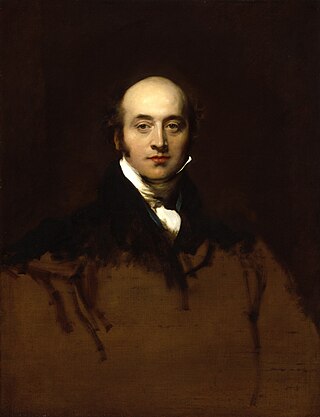
Sir Thomas Lawrence was an English portrait painter and the fourth president of the Royal Academy. A child prodigy, he was born in Bristol and began drawing in Devizes, where his father was an innkeeper at the Bear Hotel in the Market Square. At age ten, having moved to Bath, he was supporting his family with his pastel portraits. At 18, he went to London and soon established his reputation as a portrait painter in oils, receiving his first royal commission, a portrait of Queen Charlotte, in 1789. He stayed at the top of his profession until his death, aged 60, in 1830.

Thomas Phillips was a leading English portrait and subject painter. He painted many of the great men of the day including scientists, artists, writers, poets and explorers.

John Opie was an English historical and portrait painter. He painted many great men and women of his day, including members of the British Royal Family, and others who were notable in the artistic and literary professions.

William Etty was an English artist best known for his history paintings containing nude figures. He was the first significant British painter of nudes and still lifes. Born in York, he left school at the age of 12 to become an apprentice printer in Hull. He completed his apprenticeship seven years later and moved to London, where in 1807 he joined the Royal Academy Schools. There he studied under Thomas Lawrence and trained by copying works by other artists. Etty earned respect at the Royal Academy of Arts for his ability to paint realistic flesh tones, but had little commercial or critical success in his first few years in London.

Sir Edwin Henry Landseer was an English painter and sculptor, well known for his paintings of animals – particularly horses, dogs, and stags. However, his best-known works are the lion sculptures at the base of Nelson's Column in Trafalgar Square.
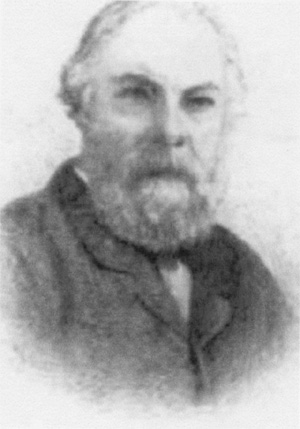
John William Inchbold was an English painter who was born in Leeds, Yorkshire. His style was influenced by the Pre-Raphaelite Brotherhood. He was the son of a Yorkshire newspaper owner, Thomas Inchbold.

Sir Augustus Wall Callcott was an English landscape painter.

James Duffield Harding was a British landscape painter, lithographer and author of drawing manuals. His use of tinted papers and opaque paints in watercolour proved influential.

Sir Charles Lock Eastlake was a British painter, gallery director, collector and writer of the 19th century. After a period as keeper, he was the first director of the National Gallery. From 1850 to 1865 he served as President of the Royal Academy, succeeding Martin Archer Shee in the role.
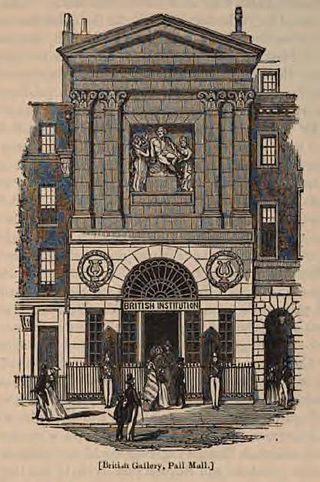
The British Institution was a private 19th-century society in London formed to exhibit the works of living and dead artists; it was also known as the Pall Mall Picture Galleries or the British Gallery. Unlike the Royal Academy it admitted only connoisseurs, dominated by the nobility, rather than practising artists to its membership, which along with its conservative taste led to tensions with the British artists it was intended to encourage and support. In its gallery in Pall Mall the Institution held the world's first regular temporary exhibitions of Old Master paintings, which alternated with sale exhibitions of the work of living artists; both quickly established themselves as popular parts of the London social and artistic calendar. From 1807 prizes were given to artists and surplus funds were used to buy paintings for the nation. Although it continued to attract members and visitors, in 1867, when the lease on its quarters expired, instead of renewing the society wrapped up its affairs.

George Henry Harlow was an English painter known mostly for his portraits.
The American Academy of the Fine Arts was an art institution founded in 1802 in New York City, to encourage appreciation and teaching of the classical style. It exhibited copies of classical works and encouraged artists to emulate the classical in their work. The mayor of New York city at the time, Richard Varick, and Gulian Verplanck, a New York politician, were some of the academy's original organizers. Younger artists grew increasingly restive under its constraint, and in 1825 left to found the National Academy of Design.

Richard Evans (1784–1871), was an English portrait-painter and copyist, a pupil and later assistant of Sir Thomas Lawrence.

Snow Storm: Hannibal and his Army Crossing the Alps is an oil on canvas painting by J. M. W. Turner, first exhibited in 1812. Left to the nation in the Turner Bequest, it was acquired by the National Gallery in London in 1856, and is now held by the Tate Gallery.

Candaules, King of Lydia, Shews his Wife by Stealth to Gyges, One of his Ministers, as She Goes to Bed, occasionally formerly known as The Imprudence of Candaules, is a 45.1 by 55.9 cm oil painting on canvas by English artist William Etty, first exhibited at the Royal Academy in 1830. It shows a scene from the Histories by Herodotus, in which Candaules, king of Lydia, invites his bodyguard Gyges to hide in the couple's bedroom and watch his wife Nyssia undress, to prove to him her beauty. Nyssia notices Gyges spying and challenges him to either accept his own execution or to kill Candaules as a punishment. Gyges chooses to kill Candaules and take his place as king. The painting shows the moment at which Nyssia, still unaware that she is being watched by anyone other than her husband, removes the last of her clothes.
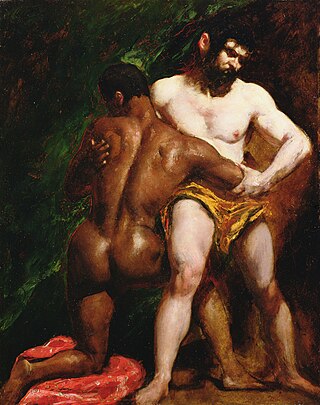
The Wrestlers is an oil painting on millboard by English artist William Etty, painted around 1840 and currently in the York Art Gallery, in York, England. It depicts a wrestling match between a black man and a white man, both glistening with sweat and under an intense light emphasising their curves and musculature. While little documentation of the painting exists prior to 1947, it is likely that it was painted over a period of three evenings at the life class of the Royal Academy.
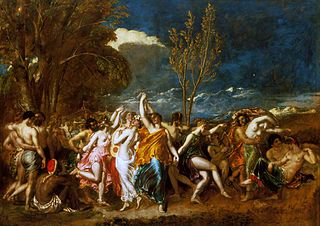
The World Before the Flood is an oil-on-canvas painting by the English artist William Etty, first exhibited in 1828 and currently in the Southampton City Art Gallery. It depicts a scene from John Milton's Paradise Lost in which, among a series of visions of the future shown to Adam, he sees the world immediately before the Great Flood. The painting illustrates the stages of courtship as described by Milton; a group of men select wives from a group of dancing women, drag their chosen woman from the group, and settle down to married life. Behind the courting group, an oncoming storm looms, foreshadowing the destruction which the dancers and lovers are about to bring upon themselves.

The Triumph of Cleopatra, also known as Cleopatra's Arrival in Cilicia and The Arrival of Cleopatra in Cilicia, is an oil painting by English artist William Etty. It was first exhibited in 1821, and is now in the Lady Lever Art Gallery in Port Sunlight, Merseyside. During the 1810s Etty had become widely respected among staff and students at the Royal Academy of Arts, in particular for his use of colour and ability to paint realistic flesh tones. Despite having exhibited at every Summer Exhibition since 1811, he attracted little commercial or critical interest. In 1820, he exhibited The Coral Finder, which showed nude figures on a gilded boat. This painting attracted the attention of Sir Francis Freeling, who commissioned a similar painting on a more ambitious scale.
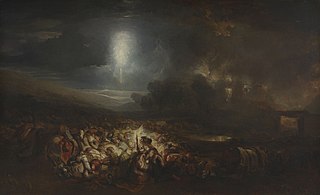
The Field of Waterloo is an 1818 history painting by the English artist J. M. W. Turner. It portrays the aftermath of the Battle of Waterloo which took place on 18 June 1815. Rather than the triumphal depictions commonplace in portrayals of the battle, it functions more as an elegy to Waterloo's unknown victims. In 1817 Turner visited the site of the battlefield and drew a number of sketches. In the background is the ruined remains of the farmhouse at Hougoumont which had played a pivotal role in the fighting. It was exhibited at the Royal Academy Summer Exhibition at Somerset House that year along with some lines from Lord Byron's poem Childe Harold's Pilgrimage "friend, foe, in one red burial blent". Part of the 1856 Turner Bequest it is now in the Tate Britain in London.



















